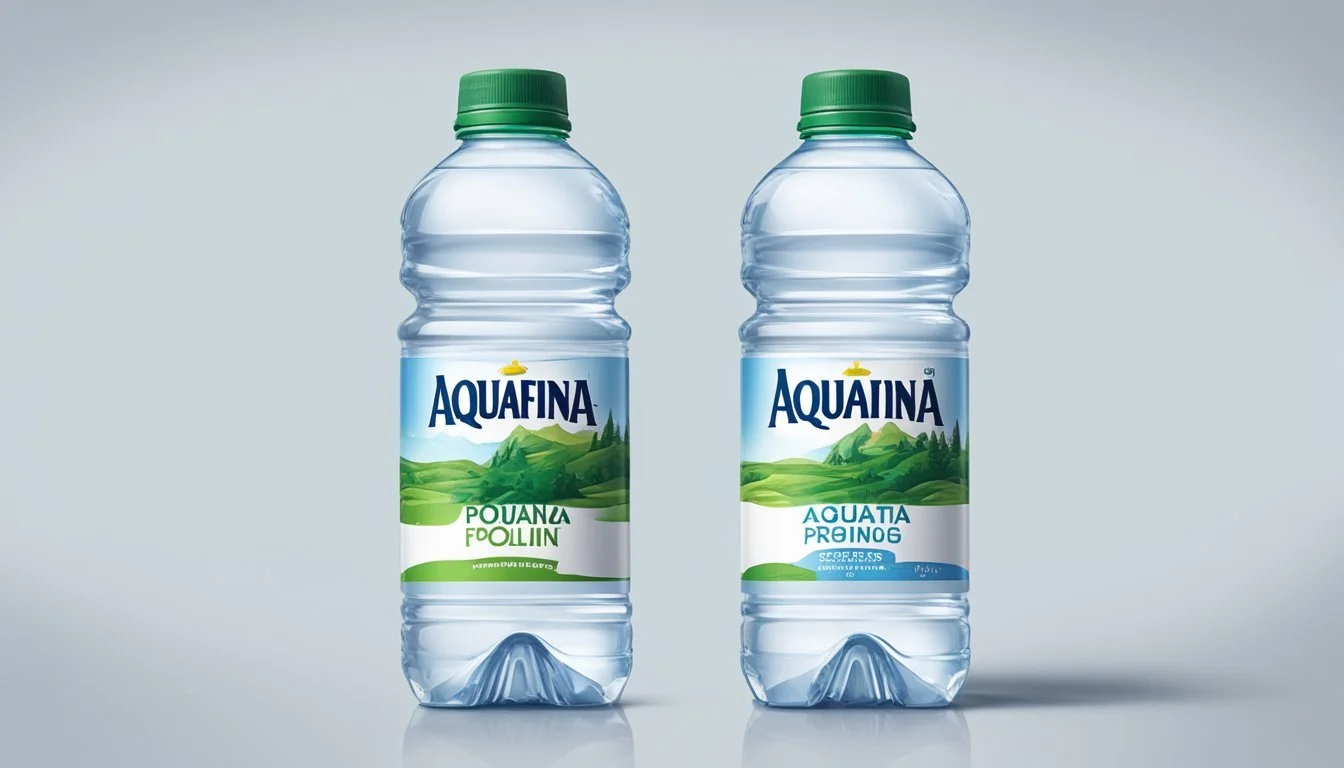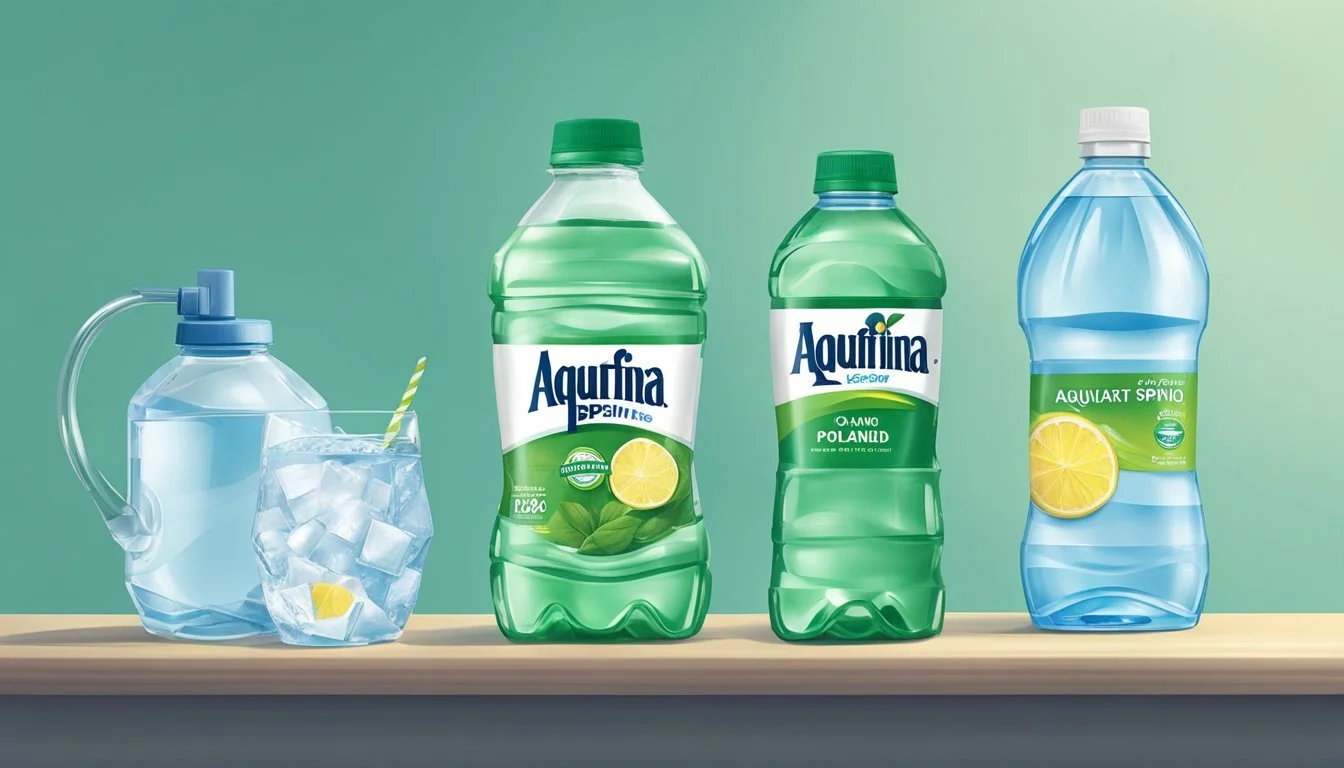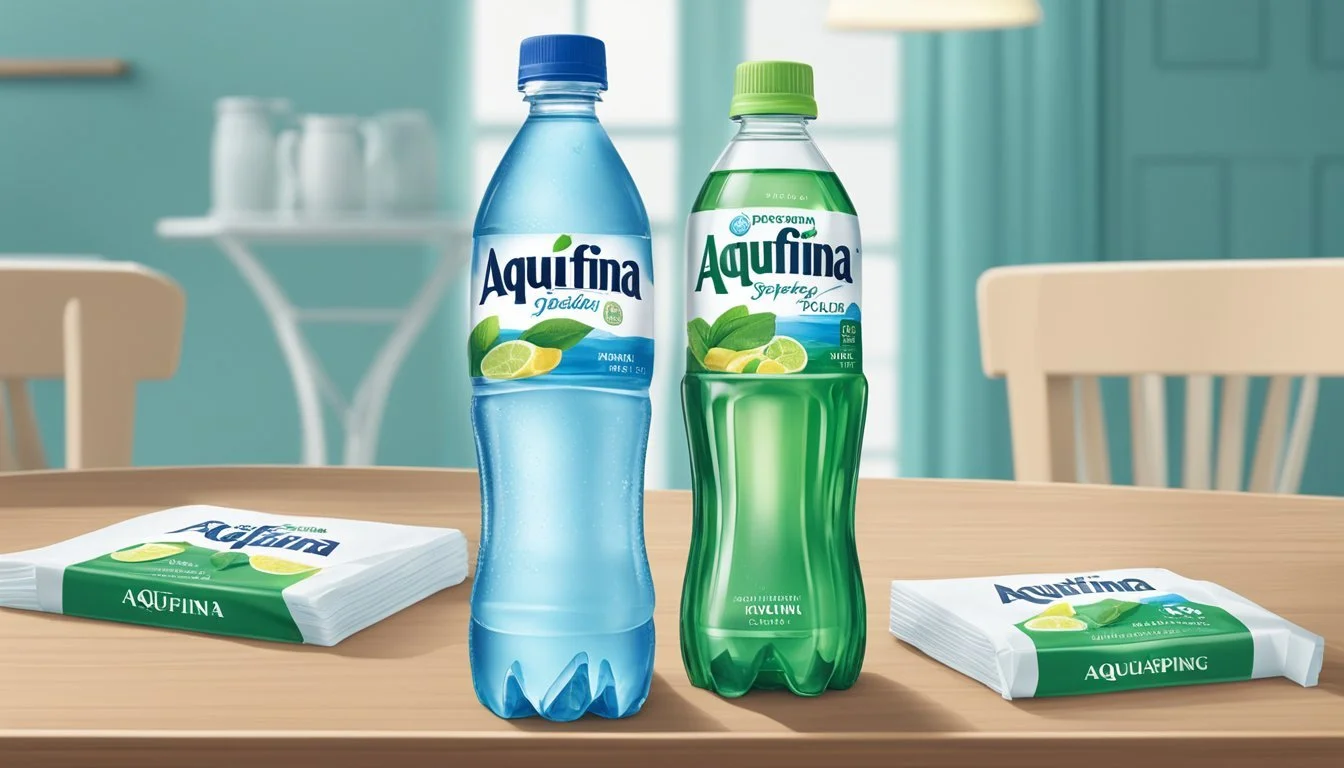Aquafina vs. Poland Spring
Assessing Quality, Taste, and Purity in Bottled Water
Choosing the right bottled water can often come down to personal preference, but there are distinct differences that set brands apart. Aquafina and Poland Spring are two prominent names in the realm of bottled water, each with its own source and purification process. Aquafina is known for its rigorous purification system, resulting in water that's significantly free from minerals and dissolved solids. Meanwhile, Poland Spring touts its natural sourcing from various springs in Maine, highlighting the fact that its water contains naturally occurring minerals, which can contribute to taste.
Consumers often debate the virtues of purified versus spring water. Aquafina, produced by PepsiCo, uses a seven-step purification process that includes reverse osmosis, ozonation, and carbon filtration, claiming to deliver pure water that's consistent in taste and quality. Poland Spring, on the other hand, has established a reputation for natural spring water that's filtered through layers of earth, giving it a distinct composition based on the particularities of its regional source.
In evaluating Aquafina and Poland Spring, it's not just about the taste—it's about understanding what each brand represents. Aquafina appeals to those seeking a crisp, clean taste with low mineral content, while Poland Spring might be preferred by individuals who enjoy the subtle taste variations provided by naturally sourced minerals. Both have established trust with consumers, but choosing which bottled water is "better" involves weighing the importance of taste, source, and purification techniques.
Background on Bottled Water
The bottled water industry has grown significantly due to consumer demand for convenience and perceived quality. This section explores the industry's rise and provides an overview of major brands that contribute to the market.
Emergence of Bottled Water
Bottled waters began as a niche product, often associated with medicinal benefits and exotic locales. Over time, advances in manufacturing and distribution turned bottled water into a staple product available worldwide. In the United States, the industry's expansion is also tightly linked to public perception of tap water quality and a growing trend towards health and wellness.
Bottled Water Brands Overview
The bottled water market features a variety of brands, each with its source and marketing angle. Nestlé Waters and Coca-Cola are two of the largest corporations in the sector. Nestlé Waters, for instance, has been critiqued for the average quality of its product, Nestlé Pure Life, despite being a leading name. Coca-Cola’s Aquafina, sources its water from public supplies, further purifying it for consistency. Many states are known for their local brands; for example, Poland Spring hails from Maine and has faced scrutiny regarding the origin of its water. This highlights the diversity and competition within the bottled water industry, with each brand aiming to secure a loyal customer base.
Comparing Aquafina Vs. Poland Spring
Aquafina and Poland Spring are two prominent bottled water brands, each with distinct characteristics. Aquafina, produced by PepsiCo, is marketed as purified drinking water. It undergoes a rigorous purification process that includes reverse osmosis, ozone sterilization, and ultraviolet light. The process strips away minerals and contaminants, resulting in water that is praised for its purity and clean taste.
Poland Spring, originating from Maine, is a source of natural spring water. It is collected from multiple springs in the state and is acclaimed for its crisp and refreshing taste. The brand emphasizes its water is naturally filtered and boasts a unique mineral composition that affects its flavor profile.
Feature Aquafina Poland Spring Source Public water sources Natural springs in Maine Filtration Reverse osmosis and other purification Naturally filtered through soil and rock Taste Clean and pure Crisp and refreshing Minerals None added post-filtration Contains naturally occurring minerals
The choice between Aquafina and Poland Spring may come down to personal preference in taste and belief in the benefits of natural minerals. While some consumers prefer the taste of Aquafina for its absence of minerals, others favor Poland Spring for its natural mineral content and the belief that it contributes to the overall taste and healthfulness of the water. Each brand holds its own in the market, catering to different consumer desires for either purified or natural spring water.
Water Sourcing and Purification Methods
In the bottled water industry, water sourcing and purification are two pivotal factors that consumers consider when choosing their preferred brand. Aquafina and Poland Spring stand out in the market by employing distinct methods for water purification and sourcing, focusing on delivering quality and adherence to safety standards.
Aquafina's Purification Process
Aquafina, a brand of bottled water products produced by PepsiCo, sources its water from public water supplies before subjecting it to a rigorous purification process. The defining feature of Aquafina's process is the 7-step HydRO-7™ filtration system which includes the following stages:
Carbon filtration: Removes organic compounds and chlorine that affect taste and odor.
Reverse osmosis: This step is critical in removing inorganic compounds such as salts and other possible contaminants like PFAS chemicals.
Ultraviolet (UV) sterilization: Ensures microbial safety.
Through this method, Aquafina aims to produce pure water that is free from minerals, contaminants, and taste.
Poland Spring's Water Source
On the other hand, Poland Spring is a brand known for its spring water, which is sourced from natural springs located in Maine, USA. The brand emphasizes the natural origin of its water, which filters through soil and rocks in the ground, acquiring minerals that contribute to its taste. The source springs are selected based on both quality and sustainable yield and are monitored to ensure the following:
Water Quality: Regular testing is performed to ensure that the water meets federal and state standards.
Natural Composition: The natural filtration through soil and rock layers provides a unique mineral composition intrinsic to the Poland Spring brand.
Poland Spring emphasizes that their water is packaged as natural spring water, which means that minimal treatment is required, unlike purified water which undergoes extensive processing to remove all materials other than H2O.
Taste and Quality Analysis
Aquafina and Poland Spring represent two major players in the bottled water market, each with distinct taste and quality profiles. Aquafina is known for its ultra-purified water, which undergoes a rigorous filtration process including reverse osmosis. This lends Aquafina a clean taste, often described as neutral with no discernible aftertaste.
Poland Spring, on the other hand, is a natural spring water. It boasts a unique mineral content that contributes to its flavor profile. Consumers typically note that Poland Spring has a fresh taste with a hint of minerals. The presence of these natural minerals can affect both the taste and the aftertaste, giving it a characteristic difference from purified waters like Aquafina.
When evaluating quality, Aquafina adheres to stringent purification standards to ensure a consistent and clean-tasting product. The absence of minerals makes it a blank canvas, often preferred for pairing with food as it does not alter the flavor palate.
In contrast, Poland Spring's quality is attributed to its source, with each bottle purported to contain water from carefully selected natural springs. The brand's commitment to maintaining the water's natural purity means the mineral content remains intact, influencing both taste and quality.
Brand Taste Aftertaste Mineral Content Clean Taste Aquafina Neutral Minimal None Very High Poland Spring Fresh Noticeable Naturally occurring Moderate
In summary, consumers seeking a pure, unadulterated taste might prefer Aquafina, while those who enjoy a natural spring water with characteristic mineral notes may find Poland Spring to their liking.
Health and Safety Considerations
Selecting between Aquafina and Poland Spring involves evaluating their health benefits and safety protocols, specifically concerning mineral content and potential contaminants. This assessment is vital for informed consumption.
Mineral Content and Health Benefits
Aquafina, marketed by PepsiCo, is purified drinking water that undergoes a rigorous purification process that includes reverse osmosis. Consequently, it contains minimal minerals. Poland Spring, originating from multiple springs in Maine, is classified as spring water, which naturally contains essential minerals such as calcium and magnesium, key electrolytes beneficial for hydration and overall health.
Calcium Content: Important for bone health and metabolic functions.
Magnesium Content: Essential for muscle function and energy production.
Contaminants and Safety Concerns
Both Aquafina and Poland Spring adhere to FDA regulations on bottled water safety. However, various independent tests have sometimes shown different levels of contaminants like PFAS (per- and polyfluoroalkyl substances) or fluoride in bottled waters, including brands like Poland Spring. PFAS are a group of manufactured chemicals that may lead to health issues over time. Poland Spring adheres to quality tests to mitigate these risks, whereas Aquafina's purification process is designed to remove substances like lead, heavy metals, and other contaminants to ensure safety.
Lead and Heavy Metals: Removed by processes such as reverse osmosis in Aquafina.
PFAS and Fluoride: Potentially found in trace amounts; subject to rigorous testing to ensure safety below harmful levels.
Environmental Impact and Sustainability
When examining the environmental impact of bottled water, Aquafina and Poland Spring present different profiles. Aquafina, owned by PepsiCo, uses ** PET plastic bottles**, which are recyclable. The focus for Aquafina has been on reducing the amount of material used in their bottles, termed as 'lightweighting', which decreases plastic usage.
Poland Spring, a brand of Nestlé Waters, has committed to a significant sustainability initiative. By 2022, it intends to use 100 percent recycled plastic for its bottles. This initiative reduces dependence on new plastic, lowering the product's lifecycle environmental footprint.
Both brands face the challenge of plastic waste, as not all bottles are recycled due to consumer behavior and local recycling capabilities. Plastic water bottles can take over 400 years to decompose, leading to a substantial impact on the environment if not properly recycled.
Sustainable practices for these companies include:
Source management: Protecting and managing the natural springs from which the water is sourced.
Recycling initiatives: Encouraging the reclamation and reuse of bottles.
Sustainability Effort Aquafina Poland Spring Recyclable Packaging Yes Yes Use of Recycled Plastic No Yes (by 2022) Lightweight Bottles Yes Not specified
In summary, while both Aquafina and Poland Spring are making strides towards sustainability, Poland Spring's commitment to recycled plastics may position it ahead in the race for environmental stewardship among bottled water brands.
Price Comparison and Value
When comparing Aquafina and Poland Spring, the price can be a determining factor for consumers. The cost of bottled water can vary widely depending on the purchasing location, store type, and available package sizes. Generally, Aquafina, which is distributed by PepsiCo, tends to be marketed at a mid-range price point. Poland Spring, offered by Nestle Waters, is also often found at a similar price level. Both brands offer single bottles and bulk packages, with bulk purchases usually providing better value.
Aquafina (mid-range price)
Poland Spring (comparable price to Aquafina)
In terms of value, consumers consider not just the price but also the perceived quality and taste of the water. Aquafina boasts a rigorous purification process that includes reverse osmosis, which some consumers may find justifies its price. Poland Spring, sourcing water from springs in Maine, is marketed as 100% natural spring water. This might appeal to those who prefer the taste of spring water or are looking for a more natural product.
It is essential to examine the costs at multiple retailers, as prices can fluctuate. For example:
Quantity Aquafina Poland Spring Single Bottle (16.9 oz) $$1.00 - $1.50** $1.00 - $1.50 24-Pack (16.9 oz bottles) $4.00 - $6.00 $3.50 - $5.50
Prices are approximate and may vary.
Both brands are considered to be affordable options in the bottled water market. However, individual preferences for taste and source—purified versus spring water—can influence a consumer's perception of value. Thus, while the pricing of Aquafina and Poland Spring is relatively on par, value is subjective and best assessed by the consumer.
Consumer Preferences and Market Trends
In the competitive bottled water market, consumer preferences and market trends dictate the success of brands like Aquafina and Poland Spring. Factors such as perceived quality and demand/popularity are critical in understanding why customers choose one brand over another.
Perception of Quality
Consumers often associate the quality of bottled water with its source and purification process. Aquafina, a PepsiCo product, markets itself as purified drinking water, undergoing a rigorous purification process that includes reverse osmosis. On the other hand, Poland Spring positions itself as natural spring water, emanating from multiple springs in Maine. The brand's history and natural source may contribute to a perception of high quality among certain consumer segments. Sales data and brand loyalty can be influenced by these quality perceptions, driving consumers to consistently choose one brand over another based on their trust in the product's purity and origin.
Demand and Popularity
Demand for bottled water brands fluctuates based on several factors, including marketing effectiveness, availability, and consumer trends. For instance, according to IRI data, the sparkling water category, which can impact still water brands like Aquafina and Poland Spring, saw a 5.3% increase in sales, amounting to $3.6 billion. Sparkling water's rise in popularity signifies a shift in consumer preferences toward more varied bottled water offerings. Market trends suggest that both Aquafina and Poland Spring have considerable market presence, with Aquafina benefiting from PepsiCo's extensive distribution network. In contrast, Poland Spring can leverage its long-standing reputation and appeal to consumers preferring natural spring water. Sales figures and market share are indicative of brand popularity; for instance, the data on leading sparkling water brands might hint at potential growth areas for both Aquafina and Poland Spring should they choose to expand their product lines in response to market trends.
Expert Opinions and Ratings
In the domain of bottled waters, expert opinions often reflect a combination of factors including taste, source, purity, and brand reputation. Aquafina and Poland Spring have been subjects of such evaluations, with varying results.
Aquafina, categorized as a purified bottled water, is often praised for its affordability and accessibility. Experts consider its water to be distinctly clean, as it undergoes a rigorous purification process including reverse osmosis. However, its lack of distinct mineral content is sometimes noted as a drawback for those preferring a more natural taste profile.
Purification Process: Reverse Osmosis
Price: Affordable
Taste: Clean, lacking minerals
Poland Spring, on the other hand, is commonly highlighted for its source, which is natural spring water. Although reviews vary, some experts appreciate the natural mineral composition that contributes to its taste. Nonetheless, it has been subjected to criticism regarding the authenticity of its sources.
Source: Natural Spring
Price: Mid-range
Taste: Natural mineral taste
Experts have provided ratings and reviews across various platforms, considering these waters among the spectrum of "worst to best." Aquafina, due to its purification process, generally receives favorable ratings for purity but attributes like taste are subjective among reviewers. Poland Spring's ratings are influenced by its natural source, yet are mixed when factors like the brand's environmental impact enter the dialogue.
In summary, expert ratings tend to favor Aquafina's purity and price, while Poland Spring is often recognized for its natural source and taste, with both brands receiving a range of reviews based on different criteria.
Conclusion: Which Water Wins?
When it comes to bottled water, Aquafina and Poland Spring are both strong contenders. Consumer choice typically hinges on personal preferences, such as taste and the assurance of purity. Aquafina, known for its purification process, promises clean and crisp tasting water. On the other hand, Poland Spring, sourced from springs in Maine, boasts a natural mineral balance that many find appealing.
In terms of brand recognition, both brands hold considerable market presence. Aquafina, backed by PepsiCo, and Poland Spring, under the Nestlé umbrella, benefit from substantial brand awareness and trust. This recognition can influence consumer decisions, along with the taste profile they prefer.
Ultimately, both brands meet the safety standards mandated for bottled water. Here's a quick comparison:
Aspect Aquafina Poland Spring Taste Purified, crisp Natural, mineral balance Purity Advanced purification process Sourced from natural springs Brand Recognition Owned by PepsiCo Part of Nestlé's portfolio
Consumers may lean toward Aquafina for its purified taste or Poland Spring for its natural mineral content. The final verdict is less about a definitive winner and more about aligning a brand's offering with individual preference. Each has its merits, and the best choice is the one that meets the drinker's taste and purity expectations.







